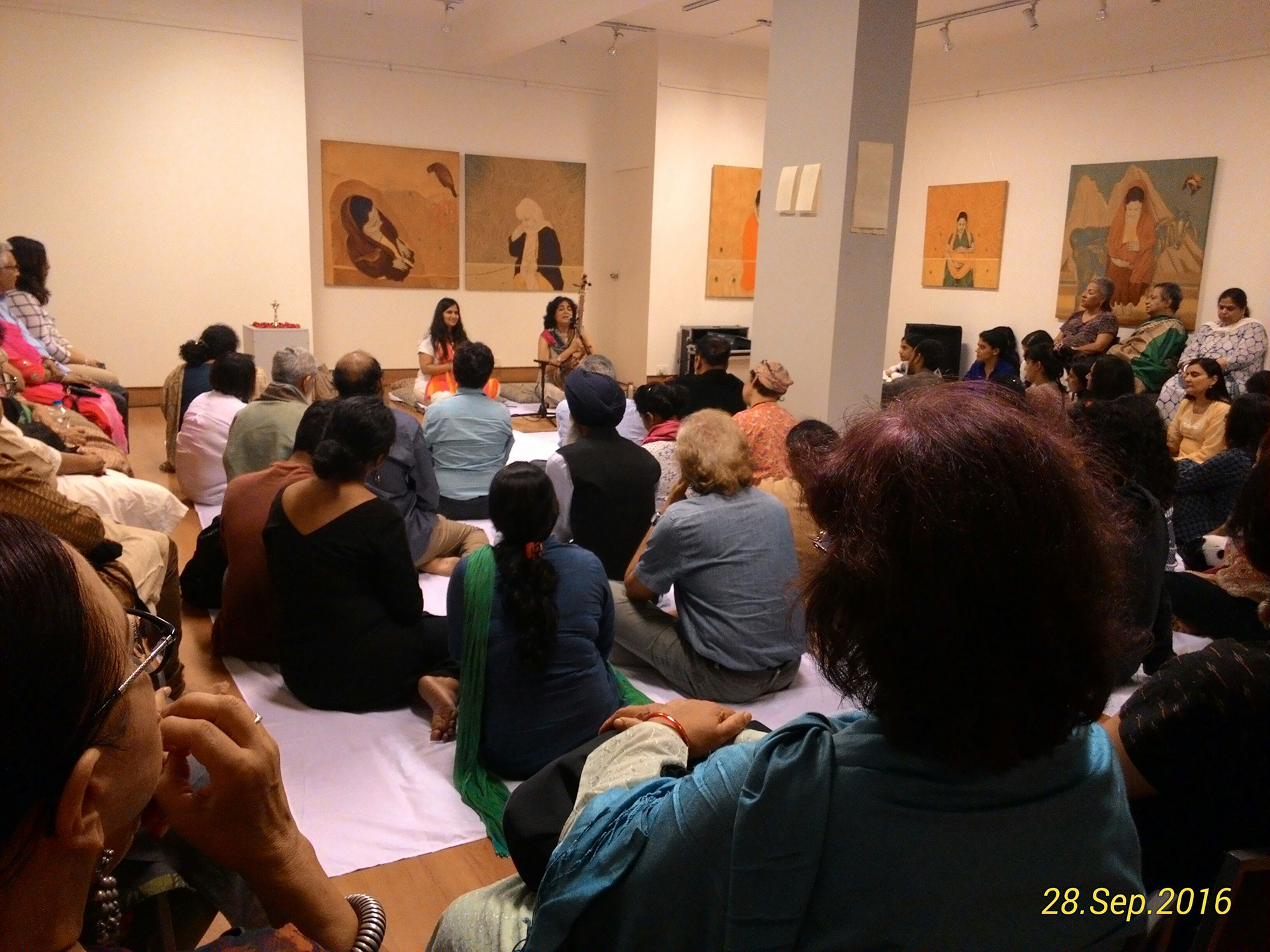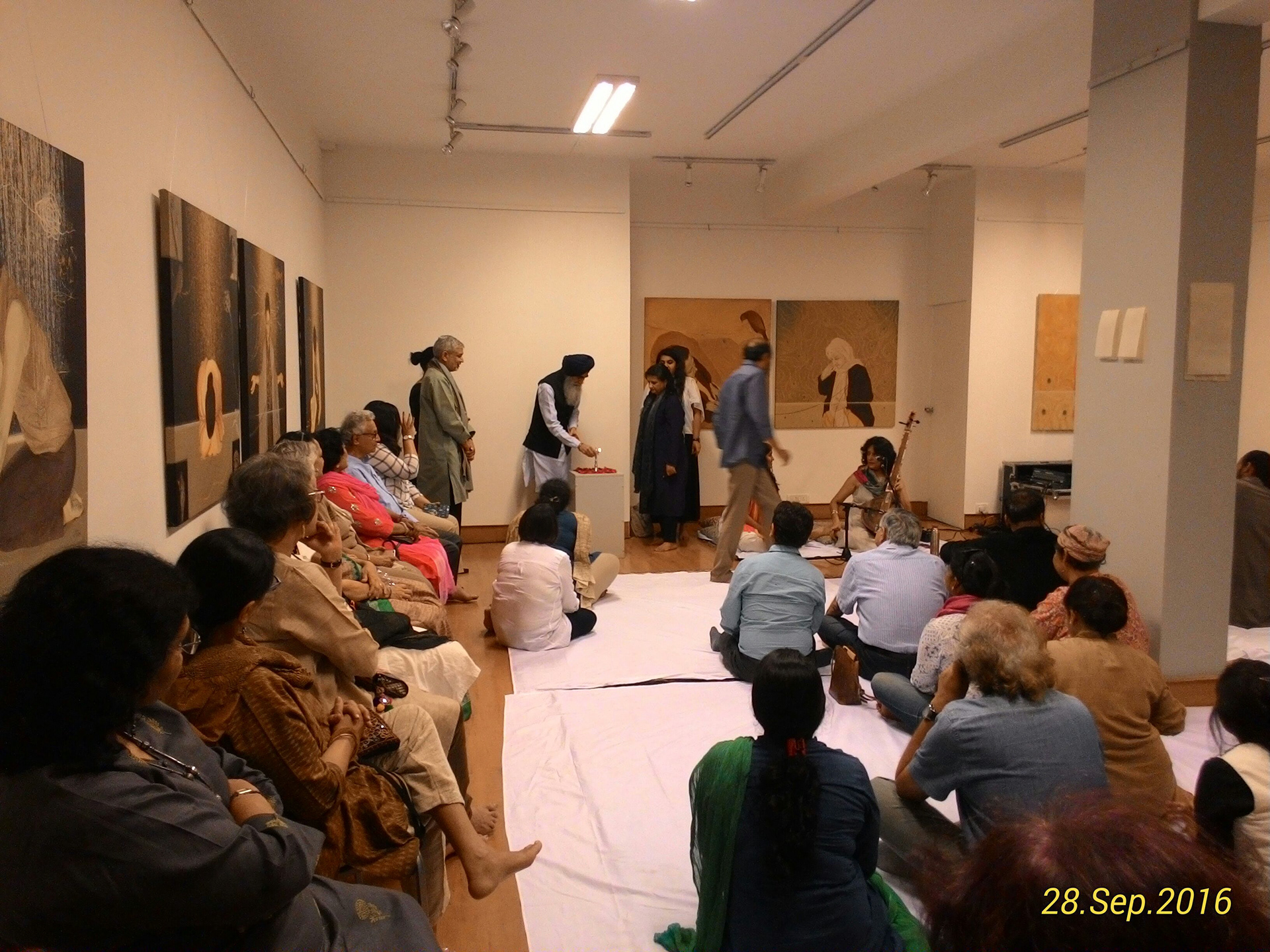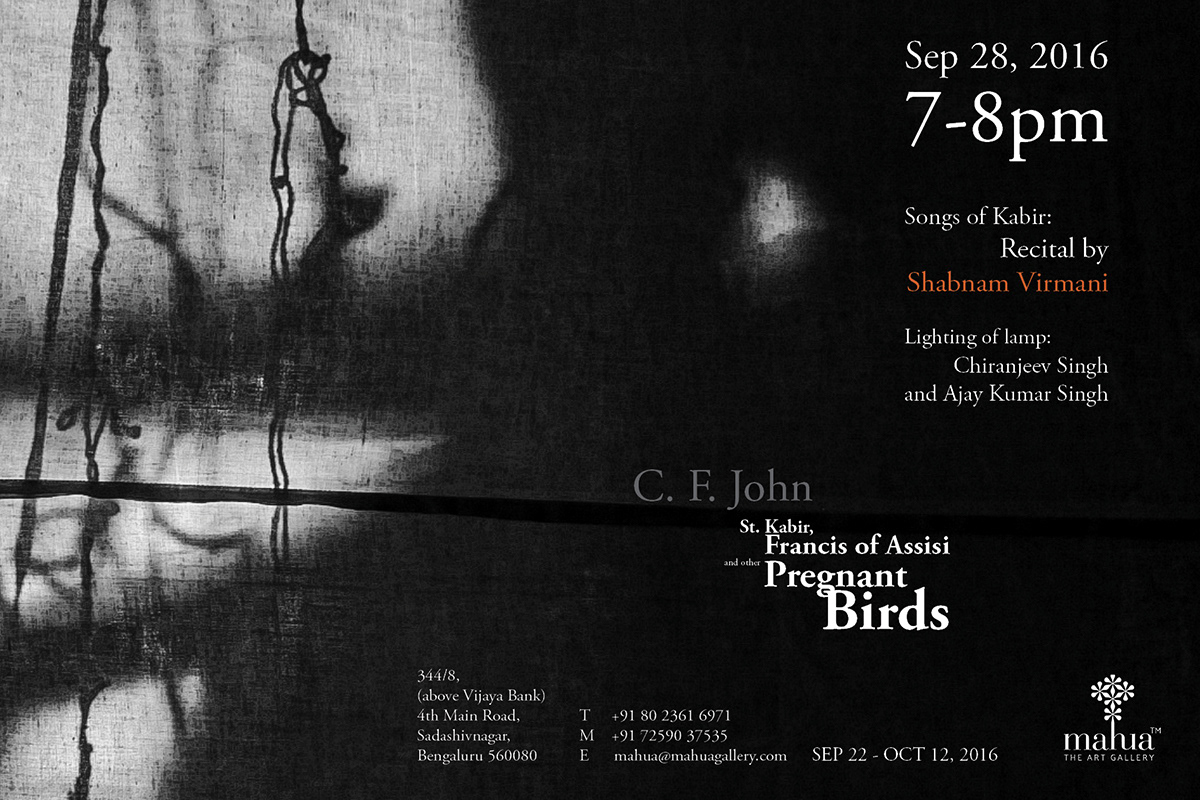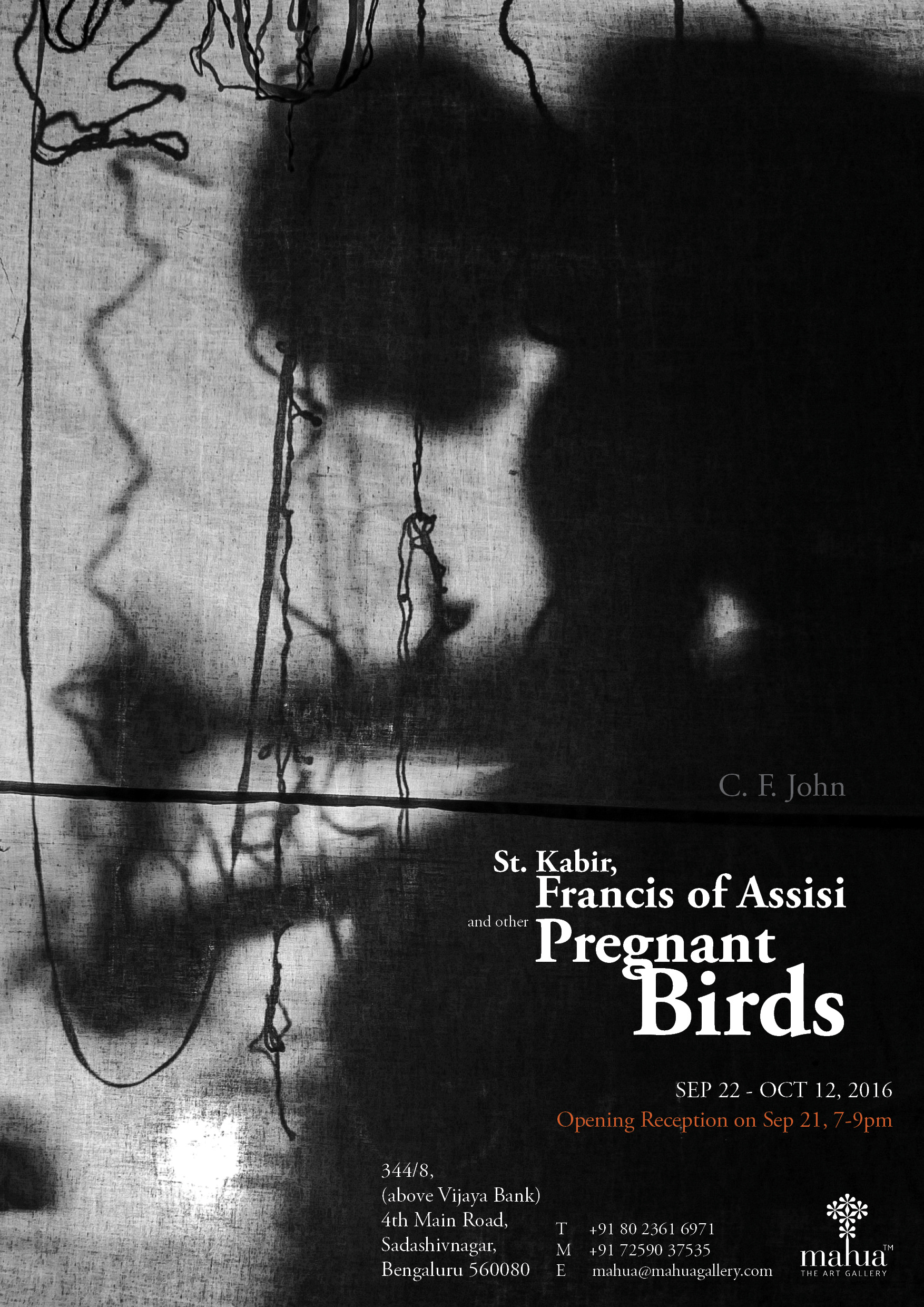St.Kabir, Francis of Assisi and other Pregnant Birds
The easel format together with the realistic foundation of the new paintings may surprise initially against John’s past of cutting-edge work. The genre, however, has not appeared out of nowhere, functioning in his previous work as fragmentary images depicted in a realistic manner as well as small found objects inserted into artworks. Apart from the fact that fairly classical ways of painting in oil and acrylic have been with John perhaps for more than the past decade, their resurgence currently comes as a great calming and meditative slowing down, as a healing direction and an assertion of essential, optimistic thoughts, aspirations and feelings. This role of the canvases can be understood when confronted with the preceding cycle of images relating to well-known extreme examples of cruelty in world history, when solace came from recalling extraordinarily kind people, like Baba Amte, universal concepts or instances of goodness and resilience. Among the canvases done during 2010-2011, there is a severe, painfully angled scene painted according to a photograph from a World War II concentration camp. The densely packed bodies of emaciated men - limp and withdrawn, incapable of covering their nakedness, may look devoid of sensation yet draw comfort from one another, while the bleak mood is yielding to a radiant vision of ample maternity. Against the raw, gloomy foreshortening of the tiered bunks, they find themselves in an uncertain spatial relationship with the fleshy apparition. The disproportionately larger breastfeeding woman remains immersed in the scene and hovers above as well as in-between it, a sensuously tangible recollection but anatomically incomplete and rounded up into an idea that nonetheless enables endurance.
The power of that corporeal vision against acute physical and mental suffering must have led to a comparison or even equation with the sacred “beyond sensory perception”, the trusted support in crisis, endangerment and doubt. For John, all activity - personal, social and aesthetic – stems from and relates to spiritual dimensions of life. Although frequently inspired by religious motifs, his metaphors evoke the grounded, culturally collective sublimation of a kind that can convince belief-neutral people. Perhaps from an instinctive regard for his own background but treated as universally emblematic, he initially relies on the figure of the 13th century rebellious but long-accepted Catholic saint, Francis of Assisi. This reformist preacher, who gave away his wealth to the poor, was close to peasant movements calling for austere poverty and the love of simple folk and creatures. As an advocate of joy among nature, popular imagination sees him accompanied by animals and birds. Kinship with the everyday, against the traditional dichotomy of the lofty spirit and sinful body, let him locate the eternal within the mundane, fleeting and carnal. The saint’s cordial and nourishing, always personally expressed affirmation in the face of the world’s violence, became a model for John when he dealt with clashing contradictions in his social work.
Among the paintings done between 2012 and 2013, one shows the monk clad in a brown habit of renunciation but embracing his alter ego as a naked human body of limitation and humility. Birds assemble towards him and enter his frame, a prey and its predator stay quietly on the edge of a perilous balance. The saint is mediating with poise between opposite energies or auras, ones which he himself epitomises in order to approximate the stabilising horizontality of water’s expanse. Amid quotations from Dali about holiness and erotic passion, John introduces the story about Francis who rolled in snow and made snow figures of his possible family that gradually melted away. The artist appreciates the honesty of Francis who, like Gandhi, transformed personal desire into the general love of existence. That honesty along with modest perseverance, despite the protracted animosity from religious authorities, merited the pope’s eventual respect. The way Francis is depicted here is able to evoke that all beings and phenomena remain on the outside as well as inside him and everyone else, the sacrosanct within the temporal. The monk’s build has a thickset, as though gentle severity, while faintly drawn, stylised organic motifs symptomatic of a refined reality superimpose on or lie under brighter, more solid ones that belong to the material world. Birds fly about patiently making nests even in hazardous circumstances and display the fertilised eggs of what John calls their “sacred urge” to bring new life, while Francis perceives them as cherubic, winged angels, since only creating life can take us beyond death.
Thus, evident differences prove to be fundamentally similar and complementary and, stimulated by Kabir, John wishes art to recognise that. Emphasising the affinity between St. Francis and the Indian poet of earthly holiness in which ultimate opposites reconcile as facets of one another, he calls the latter St. Kabir. The corresponding paintings from 2014 may seem unlike the previous series. Still, they grow from, and further than, the same. The contrast and mutual absorption of dense darkness and a light, luminous atmosphere are accentuated and clarified. From the partly illustrative, metaphor and symbol-based, almost anecdotal story-line, the language presently opts for the embodied expressiveness of the central human figure simultaneously focussed on physicality and subtle references. This visualisation evolved from the artist’s steady collaboration with the dancer-performer Tripura Kashyap. In these paintings, Amaranta Nehru, an artist and animation-film maker, has supported John with her capacity to incorporate and convey her experience of and response to the character and behaviour of the world outside, of art works and artists. Among the shadows of the existential enigma and that of the earth, she finds a basis in her own body, the head usually lowered towards itself and the gently glowing ground. She may be seated with a baby in her lap, stand with outstretched arms as if a tree or lean to the soil suggesting generative forces and the umbilical bond between regions of the world, between people, birds and plants. A mother goddess who links the materiality of the womb, moon and earth with their metaphysical associations oriented at the sky, she is sensitive to what Kabir intuited as merging of all elements, entities and spaces. Hence, upside-down shapes enter here with plants and fish inhabiting the air, whereas birds scatter underneath and illumination becomes just another side of darkness. Such absorbing of everything comes to the verge of dissolution, the quite concrete figures about to become part of the light-speckled dust that runs vertically through the sky, their bodies and soil. The artist indicates that we are only a surrendered fraction of the ever-flowing permutations of life, its beauty, sustaining and creative powers at the same time carrying seeds of hardship, violence and decay.
During 2015 and into 2016, the universal, allegorically evocative performance has ceded position to a much brighter, warmer and immediate vision of a magnificently ordinary state of expectancy. In it, too, however, the soft, mundane intensity contains its godly, otherwise just sublime, plane. The gestures still carry meaning but to be recognised potentially under their domesticity. One need not know that the model here was John’s wife Reena, the intimate anchoring of the broad address cannot be missed. The impact of these canvases too depends much more on the pure expressiveness of the rudimentary, daily presences and stances. The central image of ripe pregnancy has a rounded frame emphasised by the centrifugal arrangement of its clothes and head stole culminating in the arms embracing the belly. This curving rhythm appears to gather and internalise the surrounding air and space, while the head lowers itself to what is in the body and to the incandescent ground. Amid the opposite trajectories of rival energies, the composition trusts the unifying and stabilising, serene command of the earth, its guiding, healing radiance and warmth. The delicate yellows of potency that mediate a peaceful whiteness often tend towards the orange of a seed ready to sprout.
The corporeal and ground hub keeps reminding the spectator that it is only in this body, in this place, in this life, that we can make our best efforts and endow them with spiritual significance. The painting with the figure in a position of prayer may hint at that through its angled bird’s eye view perspective. The religious allusiveness is so mild that it primarily signifies regard for all life, animate and inanimate. References to icons, like mountains against the sky, stylised somewhat on north Indian Miniature aesthetics accommodate normalcy represented here by a pregnant goat that villagers come to love and sometimes are reluctant to kill for food. The pregnant woman in the canvas almost merges, identifies with the landscape and the equally pregnant goat. Elsewhere, similarly expectant ladies seat in tranquillity absorbing the pulse of the linear meanders and water eyes that encircle them. The multiple strata of water sources intersect throughout, above and beneath the earth we walk on and in which we grow plants. Their ultimate connectedness includes all locales and dimensions of time inviting us to be one with John’s “song line”.
The femininity of the figures, women always being associated with physicality, sensuality, emotionality and birthing, gradually reveals a gender neutral address. The progressive calming of the mood and reduction of meaningful and narrative details reflects this tendency. In the end, almost nothing specific is depicted in the last two canvases which nonetheless hold all the complexities and links of the previous works, their very minimal mode resulting in an enhanced effect. The paintings that veritably form a self-completing diptych have only a veil-clad torso of the woman who, sensitive to the internal and the outside, seems to bend slightly under, or together with, the linear energy arc above her and straighten along with the likewise abstract vertical stroke at the centre of her chest, while the lower canvas frame plays the function of the water level to offer stillness and reconciling stability. As the warm hues subdue over the plain ground which nonetheless remains throbbing and bonding, the images imply yet again that the metaphysical can be found right in the tangibly immediate.
Marta Jakimowicz
Francis of Assisi
Sifting through sorrow, suffering and temptation,
Sinking body into earth and mounting towards heaven,
Francis went to the very edges
To understand and love the body
To understand that the body and the spirit are not different
To understand that the warmth that makes the tree blossom
also makes us blossom within
To understand that the birds, animals, trees,
rocks, thorns, the body of the earth and
our body all share the same seasons
To understand that all things, all in the same way,
shrivel in the cold, go dormant, wait,
desire for union, allow warmth to caress,
labor, feel pain, blossom and rest in satisfaction.
Francis stayed open
with questions,
with humility and trust
Clay soaked in love,
celebrating beauty.
C.F. John
Kabir says, brother
I have gone crazy-
quietly, quietly, like a thief
my mind has slipped into the simple state.
- Kabir – the weaver’s songs, translated by Vinay Dharwadker penguin
…Be strong, and enter into your own body; for there our foothold is
firm, Consider it well, O my heart! go not elsewhere.
Kabir says: ‘put all imaginations away, and stand fast in that which you are’.
- poems of Kabir, complete works of Rabindranath Tagore, M.B.D publishers
…Once I knew what I had to do,
I gave up singing;
my sermons, my satires,
my aphorisms, my tales.
Kabir says, those who break
the circuit of the senses
aren’t very far
from the supreme station...
- Kabir – the weaver’s songs, translated by Vinay Dharwadker penguin
St. Kabir, Francis of Assisi and other Pregnant Birds
Lata Mani
All finished work distills a process even as each process is itself a distillation of work. This fact is affirmed by the dual meaning of work in its form as a noun and in its use as a verb. Language continually challenges the unthinking human tendency to divide, separate or binarize. Paradox: contrary to doxa or established opinion. C.F. John’s series St. Kabir, Francis of Assisi and other Pregnant Birds manifests such a paradox.
The paintings are the fruit of a philosophical inquiry into the relationship between the human and her environment, between her internal landscape and the external geo-social terrain. This much is clear even with no foreknowledge of the context for this series. But it would surely not surprise the viewer to learn that they bear the traces of John’s two decade effort to learn from, and work with, the land. This effort began with contemplating questions posed by a waterless step-well, led to experiments in soil regeneration and finally, in the period in which this series was painted, to engaging with issues affecting the community in which C. F. John lives and works. This “other” experiment is powerfully, if covertly, present in the series: in its subject matter and as well in its concern with intersubjectivity.
Most paintings feature a recurring female subject. She is a strong presence occupying the center of the canvas. Her eyes are trained downward. Yet she is neither self-focused in a narrow sense nor separable from her surroundings. Self and other, multiple others, inextricably coexist – human, tree, bird, rain, animal, water, mountain, the unborn baby, the swaddled child. In active, present-continuous relationship. At times contained by and within an Other. Each retaining the integrity of its form. This representation of a dynamic equilibrium of distinctive-ness within shared-ness, of distinctiveness and shared-ness elevates the series as a philosophical project. The paintings do not merely illustrate ideas. They manifest their integration.
To integrate is not to resolve the conundrum of intersubjectivity but to allow it to be fully present; to let a paradox be. And there are several on display. The human figure dominates the canvas even as its geological embedding implies its being re-proportioned in relation to the rest of nature. With one exception (a scene from what looks like a prison barracks or a concentration camp) the human appears alone, singly. Yet she is never isolated. The downward glance suggests interiority. Yet the demeanor and energy are that of connectedness. Each canvas is composed of few elements, at times clustered but more often spatially apart. Even so it emits intimacy not dispersion or separation.
There is a marked difference between the paintings of the female figure and those of St. Francis. By contrast with the former, the monk’s stance is openly – confidently –outward in orientation. It is as if the basis for connecting with the rest of nature has been understood, allowing introspection to make way for action. The series positions the spectator as witness to a mise-en-scene. We are continually returned to ourselves, to questions about inter and intra-species relationships. Gradually, imperceptibly, the idea of introspection as withdrawal is dissolved and existence discovered as a form of dynamic embeddedness.
Lata Mani is a cultural critic and contemplative writer who has recently discovered the pleasures of filmmaking. www.latamani.com
The Nest
Sometimes we spot them—
the birds rushing with twigs, grass, and feathers.
An urgency that is sacred.
An anticipation, a purposefulness.
We smell them in the air, the trees, and the soil.
A silent song.
A continuum she has no control over.
But her body is all eyes,
watching all the eyes —
the boy, the snake, the cat,
and the storm spiraling up.
What would you call it,
this persistence
of sacred duty?
C.F.John



